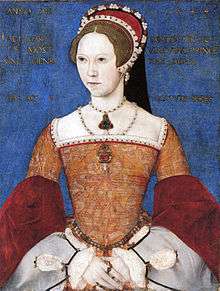First Succession Act
|
| |
| Citation | 25 Hen 8 c 22 |
|---|---|
| Territorial extent | Kingdom of England |
| Dates | |
| Royal assent | March 1534 |
| Repealed | June 1536 |
| Other legislation | |
| Repealed by | Second Succession Act |
| Relates to | Act Respecting the Oath to the Succession |
Status: Repealed | |
| Text of statute as originally enacted | |

The First Succession Act of Henry VIII's reign was passed by the Parliament of England in March 1534. The Act was formally titled the Succession to the Crown Act 1533 (citation 25 Hen 8 c 22), or the Act of Succession 1533; it is often dated as 1534, as it was passed in that calendar year. However, the legal calendar in use at that time dated the beginning of the year as March 25, and so considered the Act as being in 1533.
The Act made Princess Elizabeth, daughter of King Henry VIII by Anne Boleyn, who had been born on 7 September 1533, the true successor to the Crown by declaring Princess Mary, daughter of the King by Catherine of Aragon, a bastard. The Act also required all subjects, if commanded, to swear an oath to recognize this Act as well as the King's supremacy. Under the Treasons Act 1534 anyone who refused to take the oath was subject to a charge of treason.
The Act was later altered by the Second Succession Act, which made Elizabeth illegitimate, and the Third Succession Act, which returned both sisters to the line of succession.
The currently applicable legislation is the Act of Settlement 1701.
See also
- Act Respecting the Oath to the Succession (Succession to the Crown Act 1534)
- Second Succession Act (Succession to the Crown: Marriage Act 1536)
- Third Succession Act (Succession to the Crown Act 1543)
- Line of succession to the British throne
- Alternative successions of the English crown
Bibliography
- Cannon, John Ashton. The Oxford Companion to British History. 1st ed. Oxford [England: Oxford UP, 1997. Print.
- Gardiner, Juliet, and Neil Wenborn. The Columbia Companion to British History. New York: Columbia UP, 1997. Print.
- Haigh, Christopher. English Reformations: Religion, Politics, and Society under the Tudors. 1st ed. Oxford: Clarendon, 1993. Print.
- Loades, David. Henry VIII Court, Church and Conflict. National Archives, 2007. Print.
- Ridley, Jasper Godwin. Henry VIII. New York, NY: Viking Penguin, 1985. Print.
- Lee, Sidney, ed. (1894). "More, Thomas (1478-1535)". Dictionary of National Biography. 38. London: Smith, Elder & Co. pp. 437–8.
- Viorst, Milton. The Great Documents of Western Civilization. Philadelphia: Chilton, 1965. Print.
.svg.png)